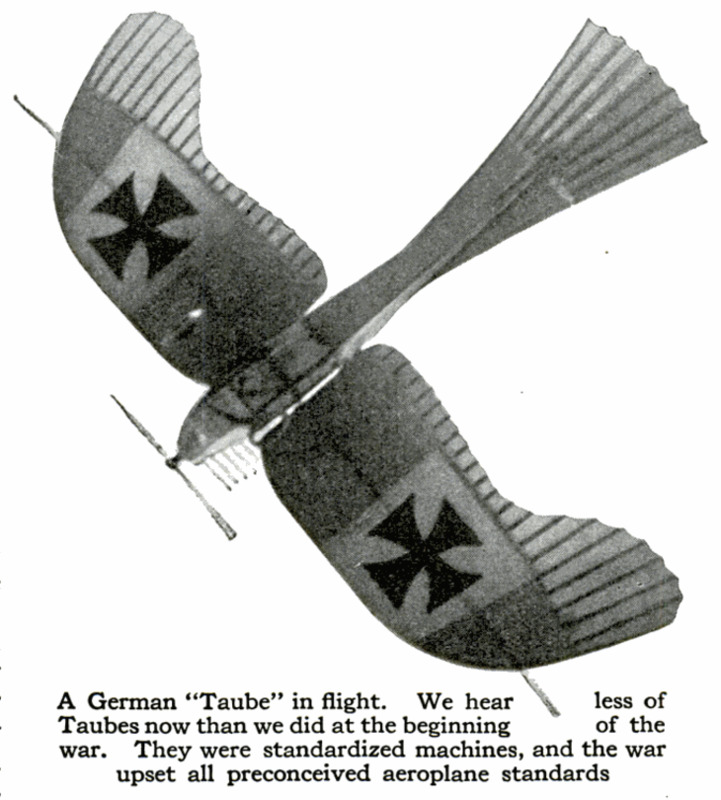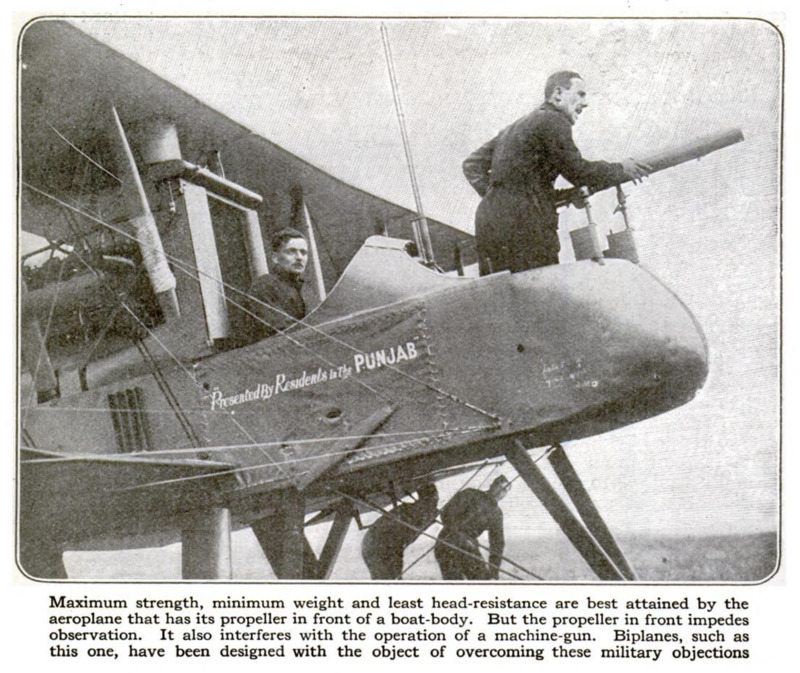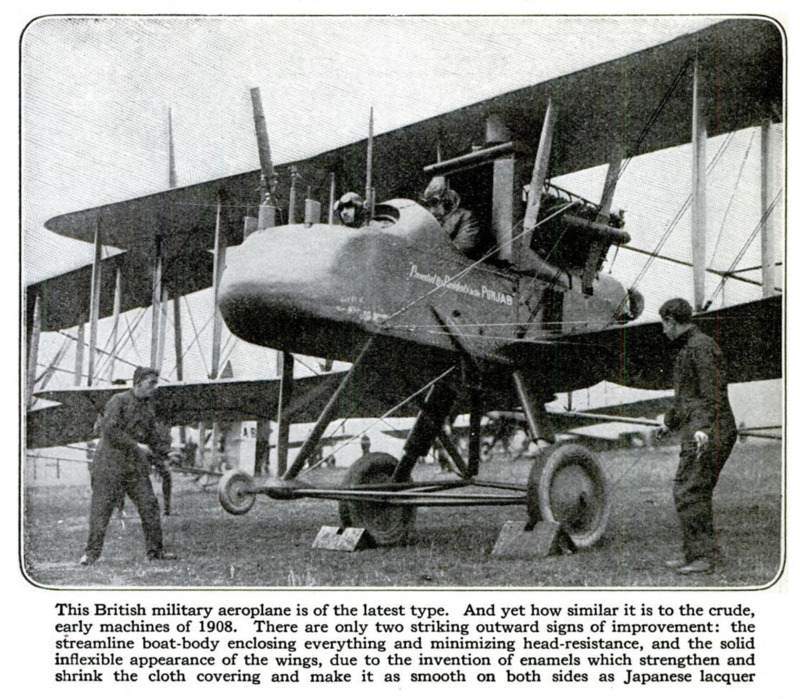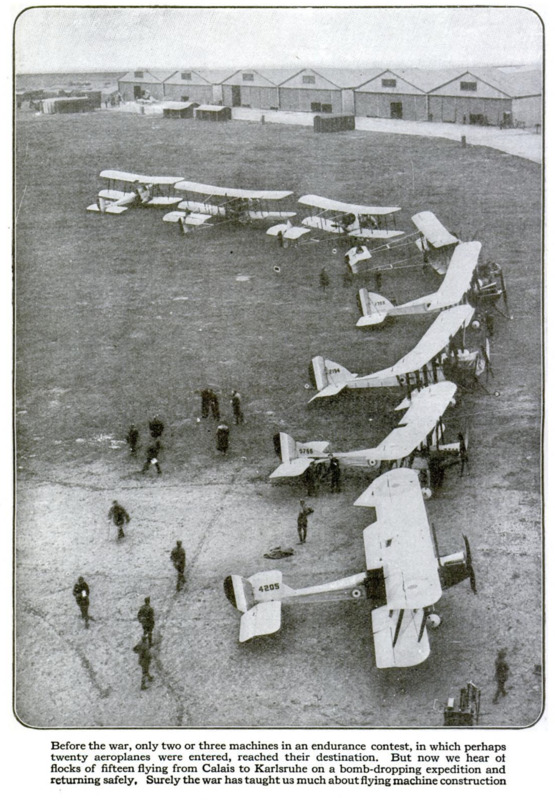-
Title (Dublin Core)
-
British military aeroplane
-
Article Title and/or Image Caption (Dublin Core)
-
War Progress in Flying
-
extracted text (Extract Text)
-
THE way aeroplanes were flown
before the war seems almost
ridiculous now, after men have
really learned how to fly as the result of
war's -exigencies. The old way made
them an easy prey for anti-aircraft guns
and for attack-
ing machines.
When it be-
came necessary °
to dart out of
the range of a
high-angle bat-
tery, which
had suddenly
revealed its
presence with
bursting shrap-
nel, or when
only a quick
maneuver
could prevent
a hostile
machine from
blocking the
way home, the
old-fashioned,
steady, level
flyer and slow
climber
proved a very
death-trap.
Looping-the-
loop, caper-cutting, all the acrobatic
performances that attend exhibition
flying became normal evolutions. Only
excess power for a sudden burst of speed
and climbing would avail in a perilous
moment.
A fast-climbing machine, which also
has the virtue of exhibiting great lifting
power in the thin air of high altitudes,
naturally vaults into the air easily in a
difficult start on rough ground. In a
critical landing—when, for instance, the
ground, which, from above seems invit-
ingly smooth, turns out to be alarmingly
rough—the fast-climbing machine can
easily stop its swift descent and leap
lightly over an obstacle. By reducing
his power while the machine is flying at
a steep angle, the pilot may even touch
the ground at a very low speed.
Salvation Lies in High Power
A machine thus able to deal with rough
ground is most stable in rough air. An
aviator fears
what he calls a
“hole in the
air—a pocket
formed by a
downwardly-
twisting cur-
rent. Into such
a hole he drops
in a sickening
way because
his wings no
longer have an
upward blast
to support
them. Hesaves
himself, not by
trying to climb
out—a useless
proceeding —
but by steering
downward,
thus increasing
his speed and
likewise the
pressure be-
neath his
wings. ‘“To go up, one must sometimes
steer up, at other times steer down,”
Wilbur Wright told me in his little
insignificant bicycle shop in Dayton,
Ohio, in 1905, in discussing the 16w-
powered Witeht machine.
Evidently the aviator needed power
to combat these difficulties. This he
obtained by resorting to surplus-powered
and reserve-powered machines. There
would seem to be no distinction between
the two terms, but the difference is this:
the surplus-powered machine has a
motor which is more than able to make
it fly and the excess power of which is
constantly used for normal flight; the
reserve-powered machine uses its excess
only in an emergency.
In the surplus-powered acroplane,
“steering down to keep up” is not a
praiseworthy maneuver. A pilot cannot
possibly know how far the “hole” or
local descending current extends and
whether he will not plunge into the
ground before he gets out of it. But
with the reserve-powered machine, it is
otherwise. When it steers up, it goes
up—always; and what is still more
important, it goes up instantly. The
words “goes up” do not apply literally.
They should read, “keeps up.” A
heavy machine cannot go up instantly
on account of its inertia, but it can as
instantly increase its lift as it can turn
on full power and put its surfaces at a
steeper angle. To steer down in order
to keep up was relatively a slow proceed-
ing, because even with the aid of gravity
inertia cannot instantly be overcome.
But with reserve power there is no need
to overcome inertia, and the remedy
can be applied at once.
With these explanations in mind, we
understand why Europeans speak as
they do of some dead officer who “lost
his life because he attempted to imitate
champions on high-powered machines
with a weak machine.”
The Germans had drawn somewhat
too hasty conclusions as to the best type
of a military aeroplane and had standard-
ized it. The French simply enlisted all
their current sporting types for army
use, types which were 5 0 in long-
range scouting, demanding, as it does,
only reliability and sturdiness in normal
flight, for which the Germans had
provided at. the war's beginning. But
the French machines were better for
aerial fighting, which has about as much
to do with steady, normal flying as a
free-for-all fight with walking in a
procession. The new art of flying had
to be learned in aerial duels, just as a
boy is taught to swim by the simple
process of throwing him overboard.
Daily encounters in the sky prove
conclusively enough that flying has been
as thoroughly mastered as horseback
riding. In neither can any attention be
paid to handling the machine. There
are too many other very important
matters to think about. The machine
must respond to any subconscious action
of its rider as obediently as a cavalry
horse, so that its guidance becomes as
much a matter of subconscious action
as that of a warhorse. Accounts of air-
duels read, in fact, as though fighting
acroplanes were under better control
than cavalry horses. To place a shot at
close range in these wild swoops, with-
out being hit, can be compared only
with fighting a saber-duel while jumping
hurdles. The fastest French and British
machines were found to be the most
formidable fighters. Hence they were
imitated (and fatally bettered) by the
Germans and Austrians.
And Yel, the Aeroplane Is
Unchanged
It is surprising how little the general
appearance of the aeroplane has changed
during its entire history, in spite of its
marvelous development. Only the
automatically stable types, distinguished
by their backwardly-turned wings and
upturned tips are an exception. But the
aeroplane is such a simple device (and
has been found best in its simplest forms)
that the phenomenon is easily explained.
There are only two striking outward
signs of improvement: the streamline
boat-body, enclosing everything and
minimizing head-resistance, and the
solid, inflexible appearance of the wings,
due to the invention of enamels which
strengthen and shrink the cloth covering
and make it as smooth on both sides as
Japanese lacquer.
Maximum strength, minimum weight
and least head-resistance are best
attained by the aeroplane that has its
propeller in front of a boat-body.
‘Thanks to the tractor-screw the biplane
has developed as much speed as the
monoplane. Itis even preferred, since its
greater surface gives more lift in emer-
gencies. Unobstructed vision in front is
often so desirable that the propeller is
sometimes placed behind the surfaces
and the boat-body shortened, in spite
of the increased head-resistance and
decreased strength of the design with
the rudders carried by poles. A beautiful
solution of the problem of free vision is
obtained in large passenger-carrying
machines, with the long bodies of which
rudders are integrally combined, two
tractor-screws and two separate motors
being mounted on both sides of the main
body. It is then essential to enclose the
motors in separate bodies. In the big
German battleplanes, the motor bodies
are long and carry the rudders. Even
such’ designs waste-a-certain amount of
power, because a catamaran has always
less speed than a single hoat. But
multiple bodies and division of load
across the span of the planes is the only
method by which large aeroplanes are
enabled to carry many passengers and
to exhibit that strength which it has
taxed all the ingenuity of the scientific
engineer to obtain even in the smaller
machine.
Has the Big Aeroplane Come
to Stay?
Mammoth aeroplanes are at present a
spectacular development, especially in
America. But it would be premature to
include them in a seriously critical
review of the acroplane of to-day. In
the main, they have not yet justified
themselves, although some of the big
water machines of Curtiss, are said to be
in frequent use. But there are no
accounts of their performances under
very critical air conditions, when their
relative lack of strength would be a very
serious matter, judging from the ex-
periences of similar smaller machines.
‘What recommended them is not economy
of performance (because they carry
relatively less per square foot of surface
than smaller water machines) but the
improved facilities offered for navigation,
comfort for long trips, and the advantage
that one pilot can transport many
passengers. They are also required,
whenever a great radius of action is
demanded, which can be obtained with
aeroplanes only by cutting down the
passenger list and carrying more fuel
instead. In a small machine, this would
mean amputating the alighting gear. |
The difficulty of starting and alighting |
with a mammoth plane is serious. - The
impact of the heavy mass is too much
for its strength, especially for the landing
wheels, which have to be made very
bulky and clumsy, consequently wasting
power in air-resistance. Transformed
into a flying boat the mammoth machine |
becomes more practical, because the hull |
partakes of all the naval advantages
that follow with increased size. Strains
to which they are subject from gusts
must be formidable. But no technical
accounts of their behavior in the air have
been published.
Air-fighting is fully as romantic
as ever were the deeds of Homer's
heroes or Cooper's Indians; for this is
the day of personal prowess in air-fight-
ing. We need not dwell solely. on the
exploits of such German supermen as
Immelmann and Boeke (each with
a record of at least fifteen victories).
Neither superiority of numbers nor of
machines cuts much of a figure if it is
matched against a certain mysterious
personal equation, which cannot as yet
be completely analyzed. It may be
safe to say that rapid, masterful marks-
manship plays in it no small part. It
would be indeed a rare coincidence if
this ability were likewise found combined
with exceptional talents (like Pégoud's)
for managing an aeroplane. If that be
the case it is obvious that a fighter and
flyer in one person must be more formid-
able than the co-operation of a mere
flyer and a mere fighter. We need only
imagine two cavalrymen on the same
horse (assuming that they could be
accommodated together as perfectly as
two flyers on a machine) of whom one
wields only the lance and the other
manipulates the bridle. How should
they communicate their respective inten-
tions in fractions of a second?
But this holds good only in regard to
small powerful racing machines which
fight wasp-like at close range.
-
Contributor (Dublin Core)
-
Carl Diestbach (writer)
-
Language (Dublin Core)
-
eng
-
Date Issued (Dublin Core)
-
1916-10
-
pages (Bibliographic Ontology)
-
523-527
-
Rights (Dublin Core)
-
Public Domain (Google digitized)
-
Archived by (Dublin Core)
-
Filippo Valle
-
Alberto Bordignon (Supervisor)
 Popular Science Monthly, v. 89, n. 4, 1916
Popular Science Monthly, v. 89, n. 4, 1916









